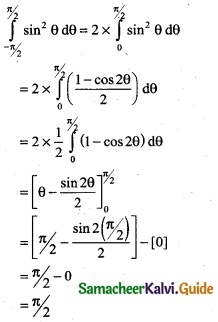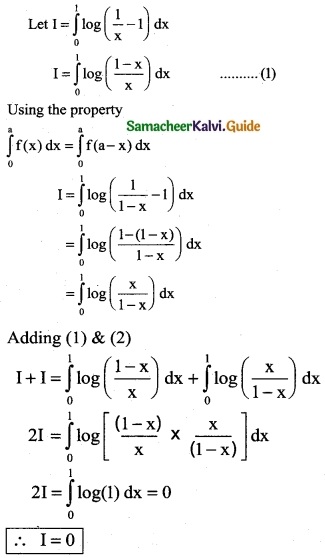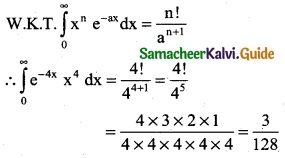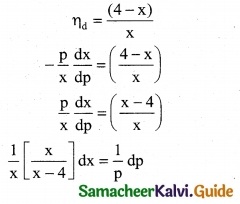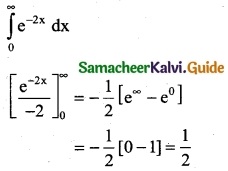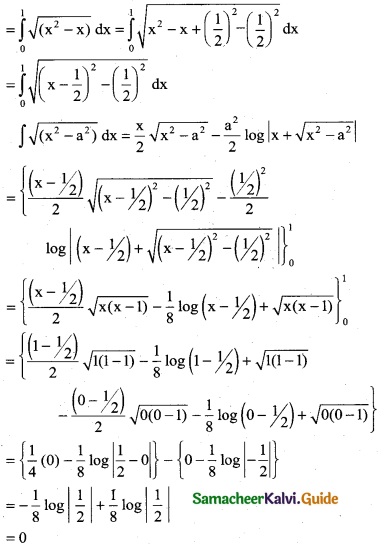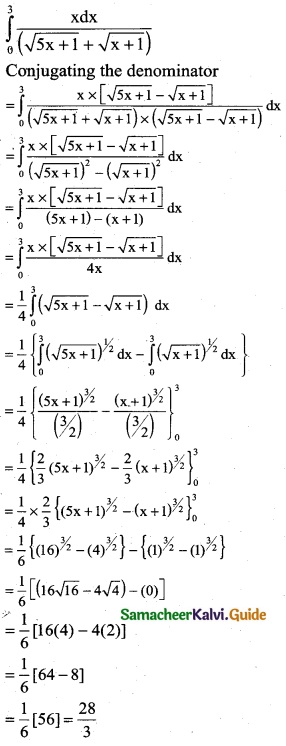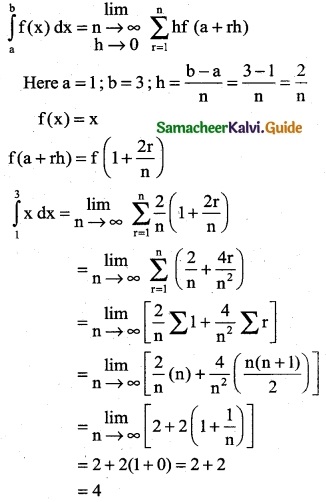Students can Download Tamil Nadu 12th Biology Model Question Paper 4 English Medium Pdf, Tamil Nadu 12th Biology Model Question Papers helps you to revise the complete Tamilnadu State Board New Syllabus, helps students complete homework assignments and to score high marks in board exams.
TN State Board 12th Biology Model Question Paper 4 English Medium
General Instructions:
-
- The question paper comprises of four parts. Questions for Botany and Zoology are asked separately.
- You are to attempt all the parts. An internal choice of questions is provided wherever applicable.
- All questions of Part I, II, III and IV are to be attempted separately.
- Question numbers 1 to 8 in Part I are Multiple Choice Questions of one mark each. These are to be answered by choosing the most suitable answer from the given four alternatives and writing the option code and the corresponding answer.
- Question numbers 9 to 14 in Part II are two-marks questions. These are to be answered in about one or two sentences.
- Question numbers 15 to 19 in Part III are three-marks questions. These are to be answered in about three to five short sentences.
- Question numbers 20 and 21 in Part IV are five-marks questions. These are to be answered in detail. Draw diagrams wherever necessary.
Time: 2.30 Hours
Maximum Marks: 70
Bio-Botany [Maximum Marks: 35]
Part – I
Choose the correct answer. [8 × 1 = 8]
Question 1.
A Plant called ‘X’ possesses small flower with reduced perianth and versatile anther. The probable agent for pollination would be _________.
(a) water
(b) air
(c) butterflies
(d) beetles
Answer:
(b) air
Question 2.
“Gametes are never hybrid”. This is a statement of _______.
(a) Law of dominance
(b) Law of independent assortment
(c) Law of segregation
(d) Law of random fertilization
Answer:
(c) Law of segregation
Question 3.
In which techniques Ethidium Bromide is used?
(a) Southern Blotting techniques
(b) Western Blotting techniques
(c) Polymerase Chain Reaction
(d) Agarose Gel Electrophoresis
Answer:
(d) Agarose Gel Electrophoresis
![]()
Question 4.
Which of the following statement is correct?
(a) Agar is not extracted from marine algae such as seaweeds
(b) Callus undergoes differentiation and produces somatic embryoids
(c) Surface sterilization of explants is done by using mercuric bromide
(d) pH of the culture medium is 5.0 to 6.0
Answer:
(d) pH of the culture medium is 5.0 to 6.0
Question 5.
The term pedogenesis is related to _______.
(a) Fossils
(b) Water
(c) Population
(d) Soil
Answer:
(d) Soil
Question 6.
Depletion of which gas in the atmosphere can lead to an increased incidence of skin cancer?
(a) Ammonia
(b) Methane
(c) Nitrous oxide
(d) Ozone
Answer:
(d) Ozone
Question 7.
A wheat variety, Atlas 66 which has been used as a donor for improving cultivated wheat is rich in _______.
(a) iron
(b) carbohydrates
(c) proteins
(d) vitamins
Answer:
(c) proteins
![]()
Question 8.
Statement A: Coffee contains caffeine.
Statement B: Drinking coffee enhances cancer.
(a) A is correct, B is wrong
(b) A and B – Both are correct
(c) A is wrong, B is correct
(d) A and B – Both are wrong
Answer:
(b) A and B – Both are correct
Part – II
Answer any four of the following questions. [4 × 2 = 8]
Question 9.
Draw and label the structure of a typical pollen grain.
Answer:

Question 10.
What is test cross? Why it is done?
Answer:
Test cross is crossing an individual of unknown genotype with a homozygous recessive. Test cross is used to identify whether an individual is homozygous or heterozygous for dominant character.
![]()
Question 11.
You are working in a biotechnology lab with a bacterium namely E.coli. How will you cut the nucleotide sequence? Explain it.
Answer:
The DNA nucleotide sequence can be cut using Restriction endonucleases (RE). Restriction
![]()
Question 12.
What is ecological hierarchy? Name the levels of ecological hierarchy.
Answer:
The interaction of organisms with their environment results in the establishment of grouping of organisms which is called ecological hierarchy.

Question 13.
Mutagens are the substances that induces mutation. Name any two physical and chemical mutagens.
Answer:
UV short waves, X-rays – Physical mutagens.
Nitromethyl, Urea – Chemical mutagens.
![]()
Question 14.
What is pseudo cereal? Give an example.
Answer:
The term pseudo-cereal is used to describe foods that are prepared and eaten as a whole grain, but are botanical outliers from grasses. Example: quinoa. It is actually a seed from the Chenopodium quinoa plant, belongs to the family Amaranthaceae.
Part – III
Answer any three questions in which question number 19 is compulsory. [3 × 3 = 9]
Question 15.
“Endothecium is associated with dehiscence of anther” Justify the statement.
Answer:
The inner tangential wall develops bands (sometimes radial walls also) of α cellulose (sometimes also slightly lignified). The cells are hygroscopic. The cells along the junction of the two sporangia of an anther lobe lack these thickenings. This region is called stomium. This region along with the hygroscopic nature of endothecium helps in the dehiscence of anther at maturity.
Question 16.
What is gene mapping? Write its uses.
Answer:
The diagrammatic representation of position of genes and related distances between the adjacent genes is called genetic mapping. It is directly proportional to the frequency of recombination between them. It is also called as linkage map.
Uses of genetic mapping:
- It is used to determine gene order, identify the locus of a gene and calculate the distances between genes.
- They are useful in predicting results of dihybrid and trihybrid crosses.
- It allows the geneticists to understand the overall genetic complexity of particular organism.
![]()
Question 17.
How synthetic seeds are developed?
Answer:
Artificial seeds or synthetic seeds (synseeds) are produced by using embryoids (somatic embryos) obtained through in vitro culture. They may even be derived from single cells from any part of the plant that later divide to form cell mass containing dense cytoplasm, large nucleus, starch grains, proteins, and oils, etc. To prepare the artificial seeds different inert materials are used for coating the somatic embryoids like agrose and sodium alginate.
Question 18.
Discuss the three zones of a lentic ecosystem.
Answer:
There are three zones, littoral, limnetic and profundal. The littoral zone, which is closest to the shore with shallow water region, allows easy penetration of light. It is warm and occupied by rooted plant species. The limnetic zone refers the open water of the pond with an effective penetration of light and domination of planktons.
The deeper region of a pond below the limnetic zone is called profundal zone with no effective light penetration and predominance of heterotrophs. The bottom zone of a pond is termed benthic and is occupied by a community of organisms called benthos (usually decomposers).
Question 19.
Write a short note on clean development mechanism.
Answer:
Clean Development Mechanism (CDM) is defined in the Kyoto protocol (2007) which provides project based mechanisms with two objectives to prevent dangerous climate change and to reduce green house gas emissions. CDM projects helps the countries to reduce or limit emission and stimulate sustainable development.
An example for CDM project activity, is replacement of conventional electrification projects with solar panels or other energy efficient boilers. Such projects can earn Certified Emission Reduction (CER) with credits / scores, each equivalent to one tonne of CO2, which can be counted towards meeting Kyoto targets.
Part – IV
Answer all the questions. [2 × 5 = 10]
Question 20.
(a) Describe dominant epistasis with an example.
Answer:

Dominant Epistasis – It is a gene interaction in which two alleles of a gene at one locus interfere and suppress or mask the phenotypic expression of a different pair of alleles of another gene at another locus. The gene that suppresses or masks the phenotypic expression of a gene at another locus is known as epistatic. The gene whose expression is interfered by non-allelic genes and prevents from exhibiting its character is known as hypostatic. When both the genes are present together, the phenotype is determined by the epistatic gene and not by the hypostatic gene.
In the summer squash the fruit colour locus has a dominant allele ‘W’ for white colour and a recessive allele ‘w’ for coloured fruit. ‘W’ allele is dominant that masks the expression of any colour. In another locus hypostatic allele ‘G’ is for yellow fruit and its recessive allele ‘g’ for green fruit. In the first locus the white is dominant to colour where as in the second locus yellow is dominant to green. When the white fruit with genotype WWgg is crossed with yellow fruit with genotype wwGG, the F1 plants have white fruit and are heterozygous (WwGg). When F1 heterozygous plants are crossed they give rise to F2 with the phenotypic ratio of 12 white : 3 yellow : 1 green.
Since W is epistatic to the alleles ‘G’ and ‘g’ the white which is dominant, masks the effect of yellow or green. Homozygous recessive ww genotypes only can give the coloured fruits (4/16). Double recessive ‘wwgg’ will give green fruit (1/16). The Plants having only ‘G’ in its genotype (wwGg or wwGG) will give the yellow fruit(3/16).
[OR]
(b) Point out the significance of plant succession.
Answer:
Significance of Plant Succession:
- Succession is a dynamic process. Hence an ecologist can access and study the seral stages of a plant community found in a particular area.
- The knowledge of ecological succession helps to understand the controlled growth of one or more species in a forest.
- Utilizing the knowledge of succession, even dams can be protected by preventing siltation.
- It gives information about the techniques to be used during reforestation and afforestation.
- It helps in the maintenance of pastures.
- Plant succession helps to maintain species diversity in an ecosystem.
- Patterns of diversity during succession are influenced by resource availability and disturbance by various factors.
- Primary succession involves the colonization of habitat of an area devoid of life.
- Secondary succession involves the re-establishment of a plant community in disturbed area or habitat.
- Forests and vegetation that we come across all over the world are the result of plant succession.
![]()
Question 21.
(a) Compare the various types of Blotting techniques.
Answer:

[OR]
(b) Explain different types of hybridization.
Answer:
Types of Hybridization:
According to the relationship between plants, the hybridization is divided into.
1. Intravarietal hybridization – The cross between the plants of same variety. Such crosses are Useful only in the self-pollinated crops.
2.. Intervarietal hybridization – The cross between the plants belonging to two different varieties of the same species and is also known as intraspecific hybridization. This technique has been the basis of improving self-pollinated as well as cross pollinated crops.
3. Interspecific hybridization – The cross between the plants belonging to different species belonging to the same genus is also called intragenic hybridization. It is commonly used for transferring the genes of disease, insect, pest and drought resistance from one species to another.
Example: Gossypium hirsutum x Gossypium arboreum – Deviraj.
4. Intergeneric hybridization – The crosses are made between the plants belonging to two different genera. The disadvantages are hybrid sterility, time consuming and expensive procedure. Example: Raphanobrassica and Triticale.
Bio-Zoology [Maximum Marks: 35]
Part – I
Choose the correct answer. [8 × 1 = 8]
Question 1.
Select the correct production site and action site of Relaxin.
(a) Hypothalamus and pituitary gland
(b) Pituitary gland and Pelvic joints and cervix
(c) Placenta and pelvic joint and cervix
(d) Hypothalamus and placenta
Answer:
(c) Placenta and pelvic joint and cervix
Question 2.
Fusion of young individuals produced immediately after the mitotic division of adult parent cell is called _______.
(a) Merogamy
(b) Anisogamy
(c) Hologamy
(d) Paedogamy
Answer:
(d) Paedogamy
Question 3.
Mangolism is a genetic disorder which is caused by the presence of an extra chromosome number ______.
(a) 20
(b) 21
(c) 23
(d) 19
Answer:
(b) 21
![]()
Question 4.
DNA finger printing techniques was developed by _______.
(a) Jacob and Monod
(b) Alec Jeffreys
(c) Frederick Sanger
(d) Hershey and Chase
Answer:
(b) Alec Jeffreys
Question 5.
Identify the correct sequence of periods from oldest to youngest
(a) Cambrian → Permian → Devonian → Silurian → Ordovician
(b) Permian → Silurian → Devonian → Ordovician → Cambrian
(c) Permian → Devonian → Silurian → Cambrian → Ordovician
(d) Cambrian → Ordovician → Silurian → Devonian → Permian
Answer:
(d) Cambrian → Ordovician → Silurian → Devonian → Permian
Question 6.
Spread of cancerous cells to distant sites is termed as _________.
(a) Metastasis
(b) Oncogenes
(c) Proto-oncogenes
(d) Malignant neoplasm
Answer:
(a) Metastasis
Question 7.
Assertion (A): Streptomycin is an antibiotic.
Reason (R): Antibiotic are microbial chemicals inhibits the growth of pathogenic microbe.
(a) A is right R is wrong
(b) R explains A
(c) A and R are wrong
(d) A is wrong but R is right
Answer:
(b) R explains A
![]()
Question 8.
World Ozone Day was observed on _________.
(a) September 16th
(b) October 12th
(c) December 1th
(d) August 18th
Answer:
(a) September 16th
Part – II
Answer any four of the following questions. [4 × 2 = 8]
Question 9.
Name the active chemical found in the medicinal plant Rauwolfia vomitoria. What type of diversity does it belongs to?
Answer:
Rauwolfia vomitoria can be cited as an example for genetic diversity. Reserpine is an active chemical extracted from Rauwolfia vomitoria.
Question 10.
State any two unique features of ELISA test.
Answer:
ELISA is highly sensitive and can detect antigen even in nanograms.
ELISA test does not require radioisotopes or radiation counting apparatus.
Question 11.
Define Anaphylaxis.
Answer:
Anaphylaxis is the classical immediate hypersensitivity reaction. It is a sudden, systematic, severe and immediate hypersensitivity reaction occurring as a result of rapid generalized mast-cell degranulation
![]()
Question 12.
Who is Cro-Magnon?
Answer:
Cro-Magnon was one of the most talked forms of modem human found from the rocks of Cro-Magnon, France and is considered as the ancestor of modem Europeans. They were not only adapted to various environmental conditions, but were also known for their cave paintings, figures on floors and walls.
Question 13.
What is S – D sequence?
Answer:
The 5′ end of the mRNA of prokaryotes has a special sequence which precedes the initial AUG start codon of mRNA. This ribosome binding site is called the Shine – Dalgamo sequence or S-D sequence. This sequences base-pairs with a region of the 16Sr RNA of the small ribosomal subunit facilitating initiation.
Question 14.
Expand (a) GIFT (b) ICSI
Answer:
GIFT – Gamete Intra – Fallopian Transfer
ICSI – Intra-cytoplasmic sperm injection
Part – III
Answer any three questions in which question number 19 is compulsory. [3 × 3 = 9]
Question 15.
Write a short note on encystment in amoeba.
Answer:
During unfavorable conditions (increase or decrease in temperature and scarcity of food) Amoeba withdraws its pseudopodia and secretes a three-layered, protective, chitinous cyst wall around it and becomes inactive. This phenomenon is called encystment. When conditions become favourable, the encysted Amoeba divides by multiple fission and produces many minute amoebae called pseudopodiospore or amoebulae.
The cyst wall absorbs water and breaks off liberating the young pseudopodiospores, each with a fine pseudopodia. They feed and grow rapidly to lead an independent life.
![]()
Question 16.
Draw a schematic representation of human oogenesis.
Answer:

Question 17.
Comment on the methods of Eugenics.
Answer:
Eugenics refers to the study of the possibility of improving the qualities of human population. Methods of Eugenics:
- Sex-education in school and public forums.
- Promoting the uses of contraception.
- Compulsory sterilization for mentally retarded and criminals.
- Egg donation.
- Artificial insemination by donors.
- Prenatal diagnosis of genetic disorders and performing MTP.
- Gene therapy.
- Cloning.
- Egg/sperm donation of healthy individuals.
Question 18.
Both strands of DNA are not copied during transcription. Give reason.
Answer:
Both the strands of DNA are not copied during transcription for two reasons.
1. If both the strands act as a template, they would code for RNA with different sequences. This in turn would code for proteins with different amino acid sequences. This would result in one segment of DNA coding for two different proteins, hence complicate the genetic information transfer machinery.
2. If two RNA molecules were produced simultaneously, double stranded RNA complementary to each other would be formed. This would prevent RNA from being translated into proteins.
![]()
Question 19.
What is Q10 value? How it is calculated?
Answer:
The effect of temperature on the rate of reaction is expressed in terms of temperature coefficient or Q10 value. The Q10 values are estimated taking the ratio between the rate of reaction at X°C and rate of reaction at (X-10°C).
Part – IV
Answer all the questions. [2 × 5 = 10]
Question 20.
(a) Differentiate between r-selected species and k-selected species.
Answer:
r – selected species:
- Smaller sized organisms
- Produce many offspring
- Mature early
- Short life expectancy
- Each individual reproduces only once or few times in their life time
- Only few reach adulthood
- Unstable environment, density independent
k – seleced species:
- Larger sized organisms
- Produce few offspring
- Late maturity with extended parental care
- Long life expectancy
- Can reproduce more than once in lifetime
- Most individuals reach maximum life span
- Stable environment, density dependent
[OR]
(b) Give a detailed account on ethanol production by microbes and the uses of ethanol.
Answer:
Ethanol production:
Saccharomyces cerevisiae (Yeast) is the major product of ethanol.
![]()
Since ethanol is used for industrial, laboratory and fuel proposes, it is called as industrial alcohol.
Organism used: Saccharomyces cerevisiae, bacteria like Zymomonas mobilis and Sarcina ventriculi.
Substances used: Molasses, Com, Potatoes, wood waste.
Process of ethanol production:
Step-1: Milling of fees stock.
Step-2: Adding fungal (Aspergillus) amylase to break down starch into sugar.
Step-3: Yeast is added to convert sugar into ethanol.
Step-4: Distillation yield 96% concentrated ethanol.
Uses of Ethanol:
Ethanol and bio-diesel are the two commonly used first generation bio-fuels.
Ethanol is used as fuel, mainly as bio-fuel additive for gasoline.
![]()
Question 21.
(a) How DNA is packed in an eukaryotic cell?
Answer:
In eukaryotes, organization is more complex. Chromatin is formed by a series of repeating units called nucleosomes. Komberg proposed a model for the nucleosome, in which 2 molecules of the four histone proteins H2A, H2B, H3 and H4 are organized to form a unit of eight molecules called histone octamere. The negatively charged DNA is wrapped around the positively charged histone octamere to form a structure called nucleosome. A typical nucleosome contains 200 bp of DNA helix.
The histone octameres are in close contact and DNA is coiled on the outside of nucleosome. Neighbouring nucleosomes are connected by linker DNA (H1) that is exposed to enzymes. The DNA makes two complete turns around the histone octameres and the two turns are sealed off by an H1 molecule. Chromatin lacking H1 has a beads-on-a-string appearance in which DNA enters and leaves the nucleosomes at random places. H1 of one nucleosome can interact with H1 of the neighbouring nucleosomes resulting in the further folding of the fibre.
The chromatin fiber in interphase nuclei and mitotic chromosomes have a diameter that vary between 200-300 nm and represents inactive chromatin. 30 nm fibre arises from the folding of nucleosome, chains into a solenoid structure having six nucleosomes per turn. This structure is stabilized by interaction between different H1 molecules. DNA is a solenoid and packed about 40 folds. The hierarchical nature of chromosome structure is illustrated.
Additional set of proteins are required for packing of chromatin at higher level and are referred to as non-histone chromosomal proteins (NHC). In a typical nucleus, some regions of chromatin are loosely packed (lightly stained) and are referred to as euchromatin. The chromatin that is tightly packed (stained darkly) is called heterochromatin. Euchromatin is transcriptionally active and heterochromatin is transcriptionally inactive.
[OR]
(b) Explain Oparin – Haldane hypothesis on evolution.
Answer:
According to the theory of chemical evolution primitive organisms in the primordial environment of the Earth evolved spontaneously from inorganic substances and physical forces such as lightning, UV radiations, volcanic activities, etc. Oparin (1924) suggested that the organic compounds could have undergone a series of reactions leading to more complex molecules. He proposed that the molecules formed colloidal aggregates or ‘coacervates’ in an aqueous environment.
The coacervates were able to absorb and assimilate organic compounds from the environment. Haldane (1929) proposed that the primordial sea served as a vast chemical laboratory powered by solar energy. The atmosphere was oxygen free and the combination of CO2, NH3 and UV radiations gave rise to organic compounds. The sea became a ‘hot’ dilute soup containing large populations of organic monomers and polymers.
They envisaged that groups of monomers and polymers acquired lipid membranes and further developed into the first living cell. Haldane coined the term prebiotic soup and this became the powerful symbol of the Oparin-Haldane view on the origin of life (1924-1929). Oparin and Haldane independently suggested that if the primitive ‘ atmosphere was reducing and if there was appropriate supply of energy such as lightning or UV light then a wide range of organic compounds can be synthesized.
Read More:











